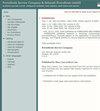Lewis antigens and argyrophilic nucleolar organizer regions staining for assessment of potential malignancy of adenomatous polyps of the gastrointestinal tract in children.
引用次数: 5
Abstract
Adenomatous polyps (AP) of the gastrointestinal tract in children are very rare. Because of their potential malignancy, they are of great clinical importance. There is little experience in the management of children with AP. The immunohistochemical expression of the Lewis blood group antigens (BGA) (sialosyl-Le(a), Le(a), Leb, Le(x), and Le(y)) and the number of activated nucleoli with the silver staining method for nucleolar organizer regions (AgNORs) were studied in two children with AP. In a girl with isolated AP of the stomach and colon, it was found that antigens Le(b) and s-Le(a) were expressed extensively in the gastric adenoma, and sialosyl-Le(a) throughout the entire length of the rectal adenoma crypts, but in the AgNORs stain the number of nucleoli ranged from two to four, evidencing changes of a benign character. In the case of familial adenomatous polyposis diagnosed in a 9-year-old boy, in some colonic adenomas the number of activated nucleoli was greater than five, and the Le(b) antigen was expressed in superficial epithelial cells in one of the adenomas. Also, extensive expression of antigens Le(y) and s-Le(a) throughout the entire length of the crypt in another polyp removed was observed. We believe that immunohistochemical study of the intensity and extent of the expression of Lewis BGA in the polyp tissue simultaneously with the determination of the number of activated nucleoli by the AgNORs staining method can be helpful in better analysis of cytological risk factors of a malignant transformation.Lewis抗原和亲嗜嗜核仁组织区染色评估儿童胃肠道腺瘤性息肉的潜在恶性。
儿童胃肠道腺瘤性息肉(AP)是非常罕见的。由于其潜在的恶性肿瘤,具有重要的临床意义。在儿童AP的治疗方面缺乏经验。我们研究了两名AP儿童的Lewis血群抗原(BGA)(唾液酰-Le(a)、Le(a)、Leb、Le(x)和Le(y))的免疫组化表达以及核核组织区(AgNORs)的银染色法活化核核数量。在一名分离胃和结肠AP的女孩中,发现抗原Le(b)和s-Le(a)在胃腺瘤中广泛表达。和唾液酰- le (a)在直肠腺瘤隐窝的整个长度范围内,但在AgNORs染色中,核仁的数量从2到4不等,证明了良性特征的变化。在一名9岁男孩确诊的家族性腺瘤性息肉病病例中,在一些结肠腺瘤中,活化核仁的数量大于5个,Le(b)抗原在其中一个腺瘤的浅表上皮细胞中表达。此外,在另一个切除的息肉中,抗原Le(y)和s-Le(a)在整个隐窝中广泛表达。我们认为,通过免疫组化研究Lewis BGA在息肉组织中的表达强度和程度,同时通过AgNORs染色法测定活化核仁的数量,有助于更好地分析恶性转化的细胞学危险因素。
本文章由计算机程序翻译,如有差异,请以英文原文为准。
求助全文
约1分钟内获得全文
求助全文

 求助内容:
求助内容: 应助结果提醒方式:
应助结果提醒方式:


